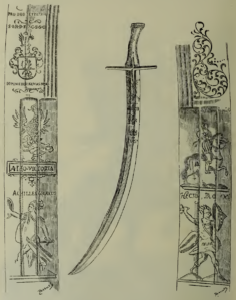The tombstone of Swabowszky György
In the monument-rich region of the Szepesség Region (Spiš), at the foot of the Magura, lies the village of Szepestótfalu / Wünschendorf / Slovenská Ves (in Slovakia). Its small church with its pointed arch was rebuilt in the last century when its original form suffered much from the anti-stylish renovation. In the western wall of its southern chapel, a tombstone of dark brown, almost black marble is fixed in an upright position, 1.82 m high and 0˙95 m wide.
Its legend is engraved in lapidary letters and not only occupies the four sides of the frame but also fills the empty spaces of the picture field in vertical rows.

We can read a not very carefully curved inscription around it. The text in Latin is the next:
EGREGIVS ET NOBILIS D[OMI]NVS VALENTINVS SCHWABOWSKY ET DOMINA ANNA VXOR PARENTES MOESTISSIMI FILIO GEORGIO SCHWABOWSKY IVVENI STRENVO PIEQ[VE] MORTVO AETA[TIS] A[NNO] 32. A[NNO] SALV [TIS] 1597. MEN[SIS]: APR[ILIS]: DIE 28. X. HORA NOCT[IS]:I[N]Q[VE] AMORIS ET MEMORIAE ERGO F[IERI] F[ECERVNT] HOC MONVMENTVM
This tombstone was thus erected by his parents, and it records precisely not only the year, month, and day, but also the hour of the mournful event that deprived them of their promising son, already on the way to a military career.

The figure, although with a smooth pillow under his head, is depicted in a fully upright position. His face is strikingly individualistic – undoubtedly a portrait – young, with a thick “Hussar” mustache, his head covered with a light hat, adorned in front with a tuft of feathers in a rose-colored bun.
His dress is the light cavalry dress, fashionable in Hungary at that time. His breastplate is a plate breastplate from the neck up (it is a “geschient”, called Gänsebauch-Gräte, crosse de pois.) This breastplate, consisting of horizontal plates, though less secure than the whole plates, was lighter and more comfortable, its overlapping plates being more easily adapted to the movements of the waist, which is why it was used mainly for light cavalry, and although abroad: Italy and Germany as early as the beginning of the 16th century, it was generally called the Hungarian breastplate, because it was most commonly used in Hungary.

The shoulder protectors and iron gauntlets are also plates, the arm protector is smooth, the legs are covered by tight, close-fitting trousers, and the feet are covered by short leather heels with spur straps attached. Raised in his right hand he holds a battle ax resting with its hilt on his armored hip, in his left he holds the hilt of a curved Turkish sword tied to his side. Both pieces of weaponry also belong to the armament of the light cavalry.

To the right of the figure’s legs is the family crest, and to the left is a spherical iron cap, open at the front of the face and protected only by a removable strap. This tombstone, although not one of the more excellent of its kind either in age or in design, is interesting, especially because of the Hungarian 16th-century cavalry armory, probably the work of a stone carver in a town in Szepes (Spiš), as is shown by its poor technique, which is mainly due to the incorrect positioning of the feet and the incorrect use of the field of the tombstone, in so far as the knight’s hat and the cover of the shield extend far into the frame.

The Sváby family of Svábóczi and Tótfalvi was an old family of Szepes County, originating from the same tribe as the Görgeys, appears in our documents in the 13th century, their names being written alternately as Svápi, Schwabowski, Svábfalvi, and Sváby in some periods. In 1265, Detrik Comes received a grant from King Béla IV in Tótfalva, and in 1294, Detrik’s son Arnold received the village of “Sváp” in exchange for the Palocsa castle, which his father Detrik Comes had built. This is the present Svábócz near the town of Poprád, from which the family took one of its names and prefixes, the other from the already mentioned Tótfalu.

In the time of the Hunyadys, the Sváby family was one of the most prestigious landowners of the county, lords of Sváb, Körtvélyes, Buson, Schewerberg, Lupnok, Helmeczvágása, Lisznecz, Sz.-Margita, Kis-Domán, Szent-Lőrincz, Szent-György, Tótfalva, Arnótfalva, and Gánfalva. The Sváby family descended from the same tribe as the Görgey, used the same title as the Görgeys.

We have no records of the life of Schwabowszky György. His mother, whose name is on the gravestone: “Anna”, was a descendant of the old extinct Korotnoky family, his father Bálint was a magistrate of Szepes County in 1586. Thirty years later in 1616, according to the same data, as a 75-80 years old – but certainly vigorous old man, he was elected commander of the county’s cavalry band and as such was killed in a battle near Nagy-Kálló in 1617.

You can read more about the area called Szepesség here:
https://www.hungarianottomanwars.com/essays/szepesseg/
Source: Arcanum and “Hagyomány és Múltidéző” https://sites.google.com/site/hagyomanyesmultidezo/

(Photo: Petr Vilgus )
Dear Readers, I can only make this content available through small donations or by selling my books or T-shirts.
If you like my writings, please feel free to support me with a coffee here:
You can check out my books on Amazon or Draft2Digital, they are available in hardcover, paperback, or ebook:
https://www.amazon.com/dp/198020490X
or at https://books2read.com/b/boYd81


My work can also be followed and supported on Patreon: Become a Patron!http://Become a Patron!



